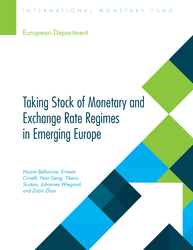
Taking Stock of Monetary and Exchange Rate Regimes in Emerging Europe
Taking Stock of Monetary and Exchange Rate Regimes in Emerging Europe
READ MORE...
Volume/Issue:
Volume 2016
Issue 012
Publication date: November 2016
ISBN: 9781475556629
$20.00
Add to Cart by clicking price of the language and format you'd like to purchase
Available Languages and Formats
| English |
Prices in red indicate formats that are not yet available but are forthcoming.
Topics covered in this book
This title contains information about the following subjects.
Click on a subject if you would like to see other titles with the same subjects.
Inflation , Money and Monetary Policy , DPPP , DP , exchange rate regime , inflation targeting , foreign currency , carry trade , financial crisis , monetary policy , exchange rate flexibility , CESEE economy , stabilization program , Exchange rate flexibility , Exchange rate arrangements , Conventional peg , Inflation , Currencies , Baltics , Global , Western Europe , Europe
Summary
The demands on monetary and exchange rate regimes in CESEE have evolved, in line with the region’s development. In the 1990s, the immediate challenge was to rein in excessive inflation following transition, and to establish basic monetary order. These objectives have been achieved, owing largely to successful exchange rate–based stabilization. With this accomplished, the focus has shifted to cyclical monetary management, and to appropriately managing monetary conditions during CESEE’s growth and income convergence to the euro area. Flexible exchange rates—and the ensuing capacity of monetary conditions to adapt to the economies’ needs—are likely to remain advantages, especially to extent that CESEE’s GDP and income levels will resume convergence to the euro area. Once this process restarts, tighter monetary conditions will again be needed to limit goods and asset price inflation, and to contain growth imbalances.
Copyright © 2010 - 2025
Powered by:
AIDC



